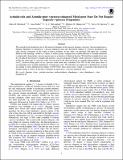| dc.contributor.author | Holmbeck, Erika M. | |
| dc.contributor.author | Frebel, Anna L. | |
| dc.contributor.author | McLaughlin, G. C. | |
| dc.contributor.author | Mumpower, Matthew R. | |
| dc.contributor.author | Sprouse, Trevor M. | |
| dc.contributor.author | Surman, Rebecca | |
| dc.date.accessioned | 2021-03-05T19:05:17Z | |
| dc.date.available | 2021-03-05T19:05:17Z | |
| dc.date.issued | 2019-08 | |
| dc.date.submitted | 2019-06 | |
| dc.identifier.issn | 1538-4357 | |
| dc.identifier.uri | https://hdl.handle.net/1721.1/130094 | |
| dc.description.abstract | The astrophysical production site of the heaviest elements in the universe remains a mystery. Incorporating heavy-element signatures of metal-poor, r-process-enhanced stars into theoretical studies of r-process production can offer crucial constraints on the origin of heavy elements. In this study, we introduce and apply the "actinide-dilution with matching" model to a variety of stellar groups, ranging from actinide-deficient to actinide-enhanced, to empirically characterize r-process ejecta mass as a function of electron fraction. We find that actinide-boost stars do not indicate the need for a unique and separate r-process progenitor. Rather, small variations of neutron richness within the same type of r-process event can account for all observed levels of actinide enhancements. The very low-Y[subscript e], fission-cycling ejecta of an r-process event need only constitute 10%-30% of the total ejecta mass to accommodate most actinide abundances of metal-poor stars. We find that our empirical Y e distributions of ejecta are similar to those inferred from studies of GW170817 mass ejecta ratios, which is consistent with neutron-star mergers being a source of the heavy elements in metal-poor, r-process-enhanced stars. | en_US |
| dc.description.sponsorship | National Science Foundation (Grant AST-1716251) | en_US |
| dc.language.iso | en | |
| dc.publisher | American Astronomical Society | en_US |
| dc.relation.isversionof | http://dx.doi.org/10.3847/1538-4357/ab2a01 | en_US |
| dc.rights | Article is made available in accordance with the publisher's policy and may be subject to US copyright law. Please refer to the publisher's site for terms of use. | en_US |
| dc.source | The American Astronomical Society | en_US |
| dc.title | Actinide-rich and Actinide-poor r-process-enhanced Metal-poor Stars Do Not Require Separate r-process Progenitors | en_US |
| dc.type | Article | en_US |
| dc.identifier.citation | Holmbeck, Erika M. et al. "Actinide-rich and Actinide-poor r-process-enhanced Metal-poor Stars Do Not Require Separate r-process Progenitors." Astrophysical Journal 881, 1 (August 2019): 5 © 2019 American Astronomical Society | en_US |
| dc.contributor.department | MIT Kavli Institute for Astrophysics and Space Research | en_US |
| dc.relation.journal | Astrophysical Journal | en_US |
| dc.eprint.version | Final published version | en_US |
| dc.type.uri | http://purl.org/eprint/type/JournalArticle | en_US |
| eprint.status | http://purl.org/eprint/status/PeerReviewed | en_US |
| dc.date.updated | 2020-10-23T13:18:40Z | |
| dspace.orderedauthors | Holmbeck, EM; Frebel, A; McLaughlin, GC; Mumpower, MR; Sprouse, TM; Surman, R | en_US |
| dspace.date.submission | 2020-10-23T13:18:50Z | |
| mit.journal.volume | 881 | en_US |
| mit.journal.issue | 1 | en_US |
| mit.license | PUBLISHER_POLICY | |
| mit.metadata.status | Complete | |
